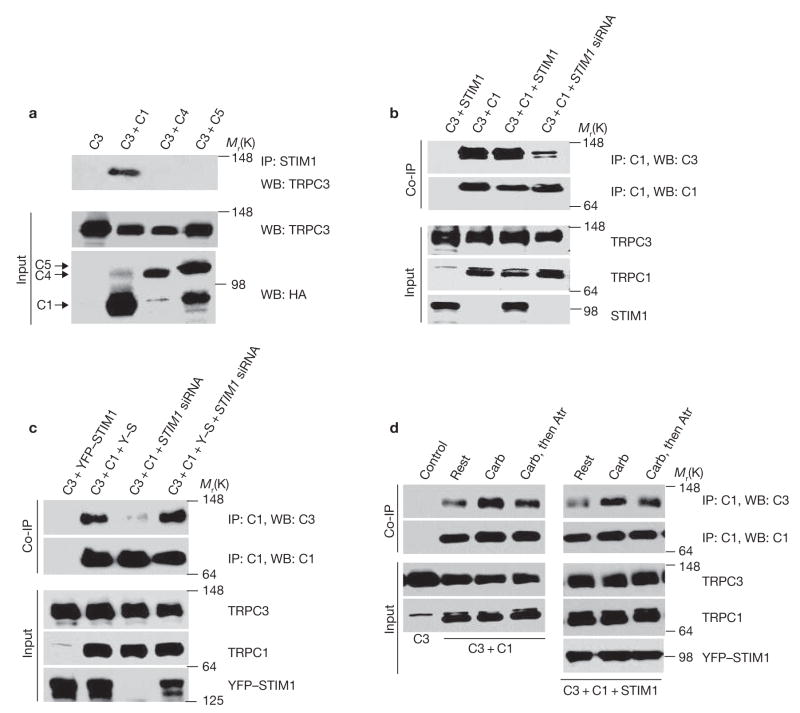Figure 2.
STIM1-mediated interaction of TRPC3 with TRPC1. (a) STIM1 specifically coimmunoprecipitates TRPC1 and TRPC3. HEK cells were transfected with Flag–TRPC3 alone (C3), Flag–TRPC3 + HA–TRPC1 (+C1), HA–TRPC4 (+C4) or HA–TRPC5 (+C5) and the extracts were used to immunoprecipitate native STIM1 and probed for coimmunoprecipitation of TRPC3. Note that TRPC1 selectively mediates the couimmunoprecipitation of STIM1 with TRPC3. (b) STIM1 is required for TRPC1–TRPC3 interaction. HEK cells treated with scrambled (first three lanes) and STIM1 siRNA were transfected with Flag–TRPC3 and Myc–STIM1 (C3+STIM1), Flag–TRPC3 + HA–TRPC1 (C3+C1) or Flag–TRPC3 + HA–TRPC1 + Myc–STIM1 (C3+C1+STIM1) and the extracts were used to immunoprecipitate TRPC1 with anti-HA antibody and probe for coimmunoprecipitation of TRPC3. Note that knockdown of STIM1 almost abolishes the coimmunoprecipitation of TRPC1 and TRPC3. (c) Rescue of TRPC1–TRPC3 interaction by cytosolic STIM1. HEK cells treated with scrambled (first two lanes) or STIM1 siRNA (last two lanes) were transfected with TRPC3 and YFP–STIM1 (Y–S) or C3+ C1+Y–S and the extracts were used to immunoprecipitate TRPC1 and probe for coimmunoprecipitate of TRPC3 and TRPC1. Note that YFP–STIM1, which does not translocate to the plasma membrane, restores the TRPC1–TRPC3 complex. (d) Agonist stimulation enhances complex formation. HEK cells were transfected with Flag–TRPC3 alone (C3, first lane control); C3+HA–TRPC1 or C3+C1+Myc–STIM1. The cells were left unstimulated (rest), were stimulated with 100 μM carbachol for 3 min or were stimulated with carbachol for 3 min and inhibited with atropine (Atr) for 3 min. At the end of the treatments, the cells were harvested to prepare the extracts that were used to immunoprecipitate TRPC1 and blot for coimmunoprecipitate of TRPC1 and TRPC3. Uncropped images of the blots are shown in the Supplementary Information, Fig. S1.

